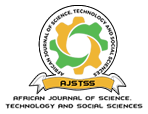Application of design thinking in steering innovation for relevance and societal impact.
DOI:
https://doi.org/10.58506/ajstss.v1i1.24Abstract
Given the definition of an innovation as an implementation of a new or significantly improved product (good or service) (Gault, 2018), it is thesis of this paper that many innovations fail to create social impacts due to lack of involvement of targeted beneficiaries. Using an innovation called ITIKI (Masinde, 2014), we demonstrate that since design thinking (DT) emphasizes on empathy, invention, and iteration, its adoption in creating social innovations helps in reversing this trend (Masinde, 2020). One way of applying DT in designing winning products/services is by pursuing four questions focusing on the what-is, what-if, what-wows and what-works (Liedtka and Ogilvie, 2011).
At the core of ITIKI is indigenous knowledge, which is defined as accumulation of knowledge passing from generation to generation, and guides communities in almost every aspect of their interactions with their environment (Mafongoya, 2017). IK has been at the heart of the coping mechanisms employed by Africa’s small-scale farmers to adapt to climatic variabilities.Though known to be very accurate in predicting, especially the short-term weather patterns, IK is highly endangered and many of its aspects are currently at the verge of extinction. Therefore, innovative ways of conserving and enhancing IK for the benefit of the small-scale farmers are required. ITIKI is one such solution - ITIKI stands for Information Technology and Indigenous Knowledge with Intelligence (https://itiki.co.za/).
ITIKI is an integrated decision support system that combines scientific weather data with IK to predict droughts. It takes the form of an early warning system with three components for: (1) drought knowledge capturing, (2) prediction and monitoring, (3) communication and dissemination of the forecasts. ITIKI is implemented using artificial intelligent algorithms, weather sensors and a mobile application. The disseminated forecasts enable the small-scale farmers make better and informed decisions, such as on when, what, how, and where to plant. The forecasts are sent via the ITIKI mobile application or SMS message. The forecasts are also accessible through a web portal, emails and audio files.
The main characteristic of ITIKI that informed the adoption of DT is the use of IK whose ownership, appreciation, understanding and application is solely in the hands of the local indigenous people. This makes it a purely human-cantered problem and for which three DT tools were applied in understanding and modelling IK: (1) brainstorming, (2) storytelling and (3) Prototyping. Besides, the problem that ITIKI addresses fits in the domain of problems favoured by DT because it deals with the hardly understood drought prediction domain and the level of uncertainty in drought prediction is very high. The end result of the above is high rate of adoption of ITIKI in Kenya, Mozambique and South Africa by more than 12,000 individual farmers and up to 11% increase in crop yields. This success is associated with the ability of to derive the unique needs of the target users (Africa’s small-scale farmers) through the systematic steps supported by design thinking.


